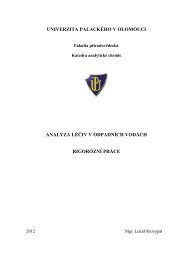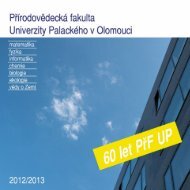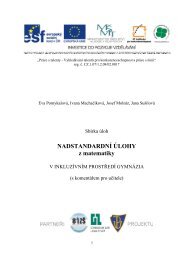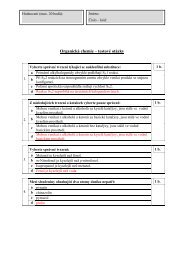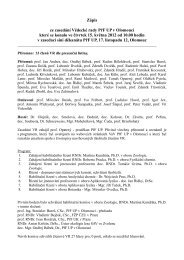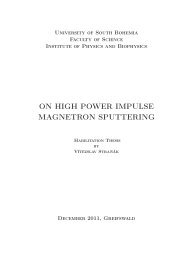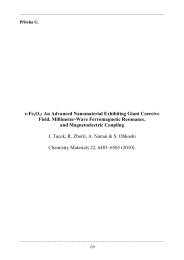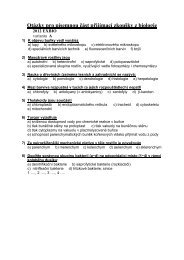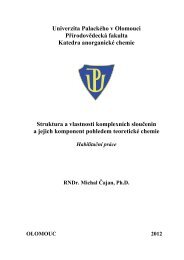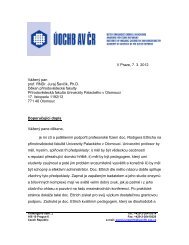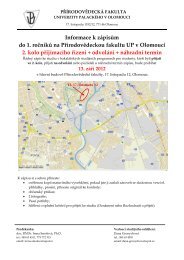A comparative structural analysis of direct and indirect shoot ...
A comparative structural analysis of direct and indirect shoot ...
A comparative structural analysis of direct and indirect shoot ...
Create successful ePaper yourself
Turn your PDF publications into a flip-book with our unique Google optimized e-Paper software.
56 M. Volgger et al.<br />
The plasma membrane remains connected to the cell wall<br />
after plasmolysis<br />
During strong plasmolysis (350 mOsm <strong>and</strong> above),<br />
Hechtian str<strong>and</strong>s are formed (Fig. 5). DiOC 6 (3), a<br />
membrane-selective dye, was used to visualise the thin<br />
Hechtian str<strong>and</strong>s <strong>and</strong> the Hechtian network close to the<br />
cell wall. Figure 5a, b shows this membranous network at<br />
different focal planes. It is evident that there is no<br />
symmetric pattern <strong>of</strong> the str<strong>and</strong>s. The Hechtian str<strong>and</strong>s<br />
are anchored to the shank <strong>of</strong> the root hair <strong>and</strong> also reach<br />
towards the tip (Fig. 5 a, b, d). In bright field mode, the<br />
Hechtian str<strong>and</strong>s are merely visible (Fig. 5c). Alternatively<br />
to DiOC 6 (3), these thin str<strong>and</strong>s are brightly stained with<br />
FM1-43, a membrane-selective styryl dye (Fig. 5d). FM1-<br />
43 is only fluorescent when incorporated into the plasma<br />
membrane <strong>and</strong> has been widely used as endocytosis<br />
marker (Emans et al. 2002; Bolte et al. 2004; Ovečka<br />
et al. 2005). With FM1-43, we observed Hechtian str<strong>and</strong>s<br />
emerging from the main protoplast as well as from subprotoplasts.<br />
The str<strong>and</strong>s are anchored to the flanks <strong>of</strong> the<br />
root hair wall, as described for DiOC 6 (3), <strong>and</strong> emerged<br />
also from the clear zone at the very tip <strong>of</strong> the root hair<br />
(Fig. 5d). Thus, strong attachment sites for Hechtian<br />
str<strong>and</strong>s have to be incorporated already within the very<br />
young, newly deposited cell wall.<br />
Root hairs adapt to osmotic stress<br />
Fig. 4 a–c Root hair tips under the fluorescence microscope. a–c Cell<br />
wall deposition at 300 mOsm mannitol; a callose staining with aniline<br />
blue (arrow). b callose/cellulose aut<strong>of</strong>luorescence after UV excitation<br />
in root hair tip showing dispersed material <strong>and</strong> a bright b<strong>and</strong> <strong>of</strong> newly<br />
formed cell wall (arrow). c Superimposing aut<strong>of</strong>luorescence <strong>of</strong> wall<br />
material after UV excitation <strong>and</strong> brightfield shows the plasmolysed<br />
protoplast. Asterisks mark the plasmolysed protoplast. Bar 10 μm<br />
cell wall that had been built at 400 mOsm becomes clearly<br />
visible in the emptying plasmolytic space (Fig. 5f).<br />
The intracellular organisation <strong>of</strong> the cytoplasm is maintained<br />
at first. Only after 2 h in strong hypertonic solutions<br />
over 350 mOsm, we observed a reorganisation <strong>of</strong> the<br />
cytoarchitecture: the reverse fountain streaming is changed<br />
into circulation streaming, <strong>and</strong> the clear zone at the tip is<br />
reduced, however maintained. The position <strong>of</strong> the nucleus as<br />
well as the velocity <strong>of</strong> organelle movement is constant.<br />
In another set <strong>of</strong> experiments, we wanted to test the<br />
adaptation <strong>of</strong> root hairs to osmotic stress conditions. For<br />
that purpose, wheat roots were grown for 24 h in glass<br />
cuvettes containing the osmotic solutions with concentrations<br />
<strong>of</strong> 150 to 450 mOsm. Growth <strong>of</strong> root hairs <strong>and</strong> the<br />
ability to form new root hairs under long-term osmotic<br />
stress were tested as well as the development <strong>of</strong> whole<br />
roots.<br />
Figure 6 shows a significant reduction <strong>of</strong> the total<br />
number <strong>of</strong> root hairs built (Fig. 6 a–d, dark field) <strong>and</strong> length<br />
<strong>of</strong> root hairs (Fig. 6e–h). Under control conditions <strong>and</strong> up to<br />
isotonic 150 mOsm, root hair development appears normal<br />
(Fig. 6a, e). At 250 mOsm, less <strong>and</strong> shorter root hairs are<br />
built than at lower concentrations (Fig. 6b, f). Interestingly,<br />
even after 24 h, newly formed root hairs appear in osmotic<br />
solutions <strong>of</strong> 350 <strong>and</strong> 450 mOsm mannitol, when normal cells<br />
react with strong plasmolysis. Under these long-term osmotic<br />
conditions, root hairs do not grow beyond a length <strong>of</strong> 50 to<br />
100 μm, but their cellular organisation is the same as in<br />
control hairs (Fig. 6e–g). Only at 450 mOsm, the clear zone<br />
at the tip is not developed properly (Fig. 6h). Plasmolysis <strong>of</strong><br />
these “hardened” root hairs is only possible with concentrations<br />
that are 200 mOsm stronger than during cultivation<br />
(data not shown). Even so, they show only mild plasmolysis




